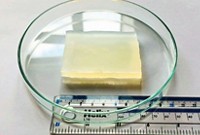Advertisement
Grab your lab coat. Let's get started
Welcome!
Welcome!
Create an account below to get 6 C&EN articles per month, receive newsletters and more - all free.
It seems this is your first time logging in online. Please enter the following information to continue.
As an ACS member you automatically get access to this site. All we need is few more details to create your reading experience.
Not you? Sign in with a different account.
Not you? Sign in with a different account.
ERROR 1
ERROR 1
ERROR 2
ERROR 2
ERROR 2
ERROR 2
ERROR 2
Password and Confirm password must match.
If you have an ACS member number, please enter it here so we can link this account to your membership. (optional)
ERROR 2
ACS values your privacy. By submitting your information, you are gaining access to C&EN and subscribing to our weekly newsletter. We use the information you provide to make your reading experience better, and we will never sell your data to third party members.
Materials
Triggerless shape-shifting polymers
Time-dependent transformations are encoded in a network of hydrogen bonds
by Celia Henry Arnaud
October 10, 2016
| A version of this story appeared in
Volume 94, Issue 40
Shape-shifting materials can be used for a variety of applications, including drug delivery and biomedical devices. They have typically relied on external triggers to induce the desired activity. Andrey V. Dobrynin of the University of Akron and Sergei S. Sheiko and coworkers at the University of North Carolina, Chapel Hill, have now developed materials that can be programmed to change shape at predetermined rates without an external trigger (Nat. Commun. 2016, DOI: 10.1038/ncomms12919). The new materials are hydrogels with dual networks of cross-links made by the copolymerization of N,N-dimethylacrylamide and methacrylic acid. The first network has a low concentration of covalent connections that provide the memory of the original shape. The second network has a high concentration of reversible hydrogen bonds that temporarily lock in a new shape but allow the material to transform back to its original shape as they dissociate. For the transformation to take place over a useful timescale, whether that be seconds or hours, the lifetime of the hydrogen bonds needs to be longer than the time it takes for the strands that make up the covalent network to relax back to their original shape. The researchers used the shape-shifting hydrogels to assemble an artificial flower with individually programmed petals that open at different times over the course of about two hours to simulate blooming.





Join the conversation
Contact the reporter
Submit a Letter to the Editor for publication
Engage with us on Twitter